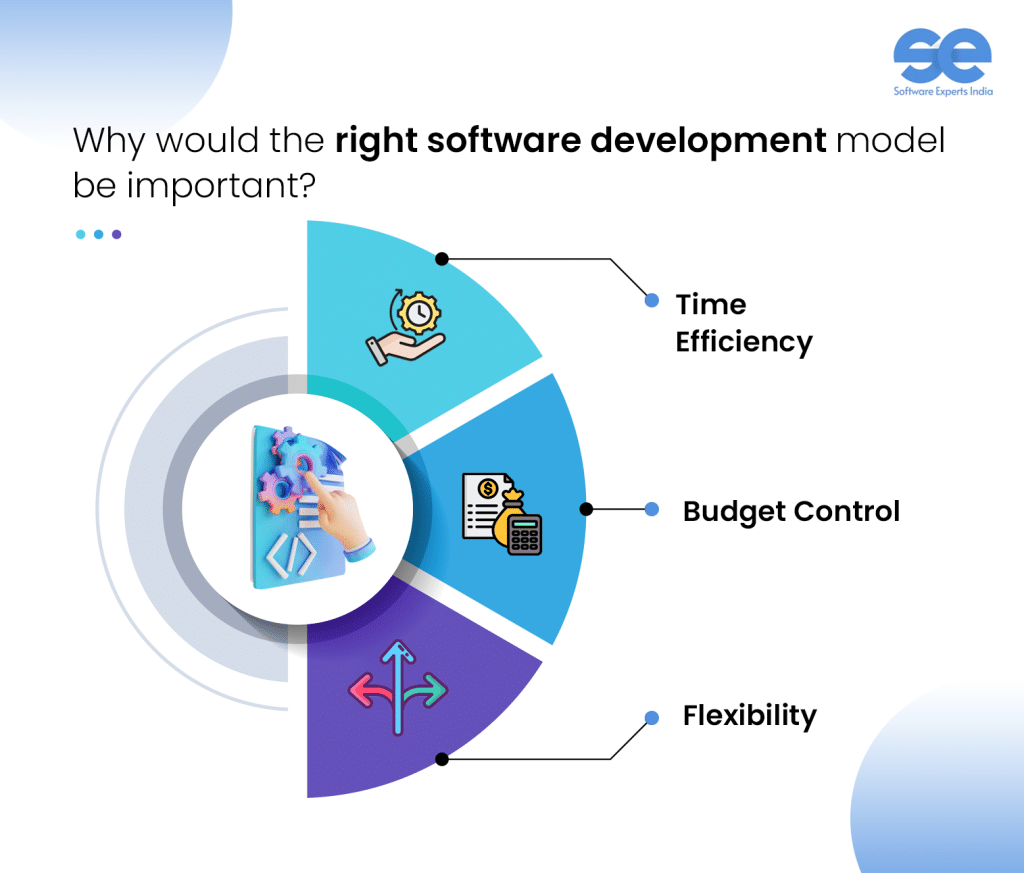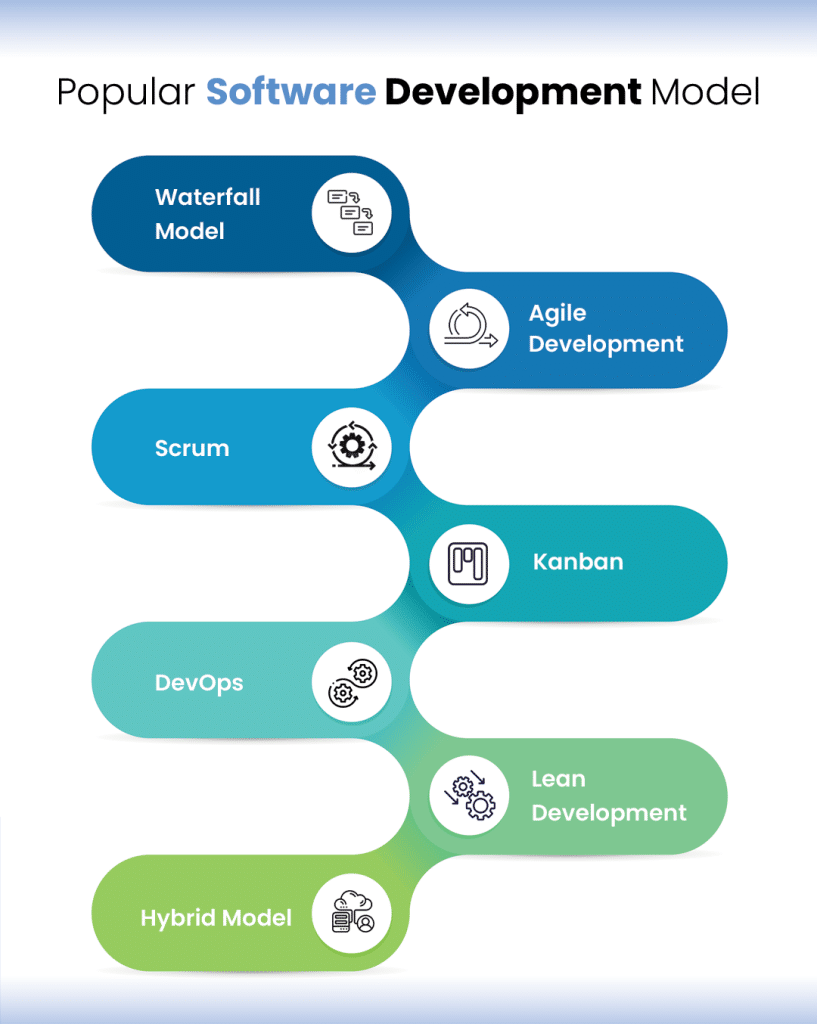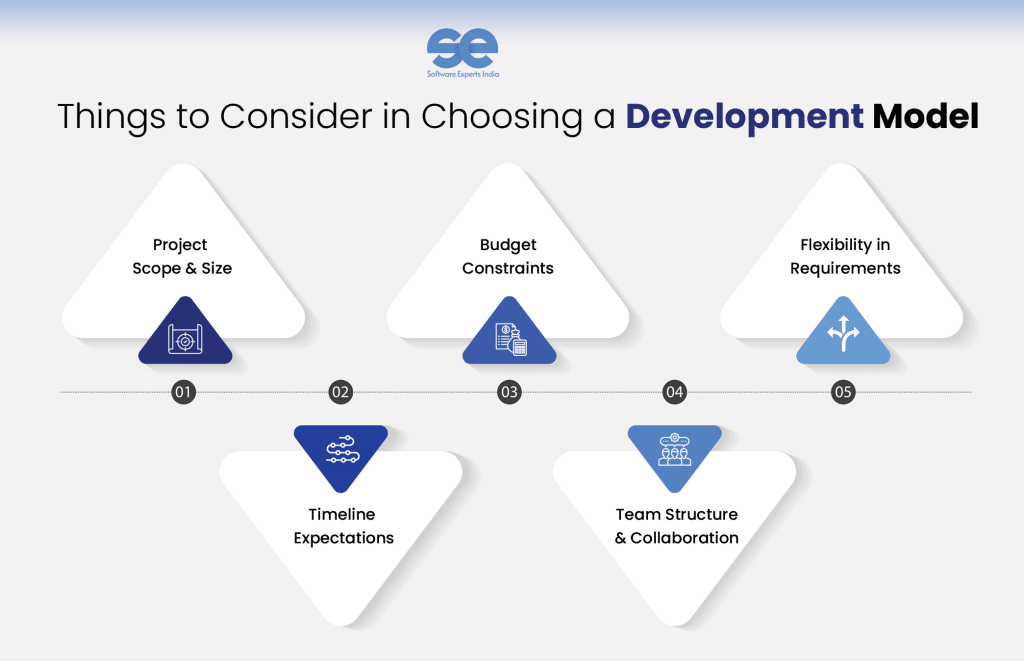Perhaps one of the most important choices when beginning the development of software is the choice of development model. A software development model defines a process by which a project unfolds from conception to coding and deployment.
There are many development models available, among which you need to choose the perfect one for your project that fits right your business needs.
In this blog, we will be discussing a wide range of development models and will analyze how they are benefiting businesses from all points of view.
In this blog, we will therefore look at various models, considerations, and how to select the right models to achieve your objective.
Why would the right software development model be important?

Selecting the right software development Model determines the performance of your project to a great extent. Your team dynamics, the ability to change the project scope, the preservation of the project’s budget, and, as a result, the quality of the product are inextricably linked to this model.
Here’s why it matters:
Time Efficiency: Some of the models, for instance, Agile, are based on flexibility and speed, and this may take a lot of time and, hence, may lead to a lot of time being spent, which is the case when using the waterfall model.
Budget Control: It is also important for different models to manage resources in different manners. With Agile, you can implement it in stages, and this comes in handy when it comes to costs. Should some changes occur mid-development, then with a model such as Waterfall, this could be very costly.
Flexibility: Agile and Scrum facilitate flexibility, which is crucial if the development project requirements change in the middle of the project life cycle. However, the waterfall model does not afford flexibility since change in any of the stages brings significant complications.
Making the wrong selection can cause serious problems, including a slowdown in project delivery, increased costs, and failure to achieve the set project objectives.
Brief Discussion on Popular Software Development Model

-
Waterfall Model
The waterfall model is known as one of the oldest and most conventional SDMs, which is used at present. It is also conventional in that one phase—requirements gathering, design, development, testing, and deployment must be carried out before the next phase is initiated.
Best Suited For : scenarios in which it’s possible to establish a clear understanding of expectations in the beginning and the scope is unlikely to evolve.
Benefits : Simple and easy to manage.
Drawbacks : The primary drawback is this is a rigid kind of model; this results in very hard means of adjusting when change requests are made in the later part of the project.
-
Agile Development
But Agile is quite the opposite—it is a more fluid, cyclical type of development. As for methodology, Agile does not dictate that all phases are to be carried out in an organized sequence but delivers features in facets.
Best Suited For: Applications or situations in which the requirements are likely to change over time or where features need to be delivered in a short time span.
Benefits: One of the advantages is that this model offers much higher flexibility, constant feedback from the users, and a higher frequency of delivering functional pieces.
Drawbacks: Demands greater interference from participants and can be more challenging to estimate the ultimate number of costs and times.
Also Read : 20 Must-Know Trends Shaping the Future of Software Development
-
Scrum
Originally, Scrum is an instance of Agile developed for interrelated teams. It organizes progress into smaller parts and has fixed periods of 2-4 weeks that are called sprints.
Best Suited For: Works that involve a lot of communication and which may need to change frequently for any number of reasons, usually in environments.
Benefits: Well-defined hierarchical management with frequent reporting and the possibility of change in a project’s development.
Drawbacks: For this model, success primarily depends on the development team’s efficiency for writing the code.
-
Kanban
Kanban is an actual visual system for WFM that keeps the product in constant flow while not overwhelming the development team. It means that work is depicted through a very familiar technology called the Kanban, and work is done based on significance.
Best Suited For: Such jobs include business involving constant shifting of schedules or work that continues over a particular period of time.
Benefits: The model offers a clear picture that shows the status of the work down to a fine level of detail. They are fully adaptable and may easily shift their attention to other matters.
Drawbacks: Sometimes it can lack structure, which makes it quite challenging to manage bigger projects.
-
DevOps
DevOps is a smoother approach that combines development and operations to increase the speed and efficiency of the delivery processes. Continuous integration, continuous testing, and continuous delivery are sample concepts in DevOps.
Best Suited For: Projects where materials need to be updated often; new versions of the materials are deployed as quickly and effortlessly as possible.
Benefits: These five benefits include faster time-to-market, better integrated & cross-functional teamwork, and dependability.
Drawbacks: Is a large cultural change that demands highly professional work teams.
-
Lean Development
Lean development is a strategy that aims at eliminating waste common in the development process. It focuses on users upping their expectations by providing only what will add value to their experience.
Best Suited For: A project that can be characterized as implementing efficient and effective solutions at a lower cost.
Benefits: It cuts the amount of time and money that is otherwise needed in development to invest in the final worthwhile features.
Drawbacks: Such an approach can cause feature selection to be oversimplified or lose features that are valuable to some degree.
Als Read : The Influence of AI and ML on Modern Enterprise Applications
-
Hybrid Model
A hybrid model involves the formulation of a business strategy from several methodologies to formulate a specific approach that fits the business. For instance, feature development may be implemented in an Agile way; while planning and designing are based on Waterfall.
Best Suited For: Operations involving the need for a strong framework coupled with adaptability.
Benefits: Gives the choice of the best strategies because the business can adjust the model according to their business needs.
Drawbacks: Not very easy to control and needs proper coordination so that the entire amalgamation can smoothly go forward.
Things to Consider in Choosing a Development Model

Selecting the right model depends on multiple factors:
-
Project Scope and Size
Agile may be appropriate for small-scale implementations for the simple reason that it is more nimble and faster than Scrum. As for the waterfall model, the large-scale requirement structure of the functions allows the model to handle complicated large functions well.
-
Budget Constraints
The principal advantage of the Agile model is that it provides gradual budget control based on the project’s progress. On the other hand, the scalability of the waterfall model is not very good since it necessitates a fixed budget, and in case of change requirements in the later phases, it could not be easy to handle.
-
Flexibility in Requirements
Since agile models are built for changes, they are suitable for projects where flexibility is of essence. Contrarily, the waterfall approach is most effective where there is a high level of stability or where project requirements are more or less fixed.
-
Timeline Expectations
If time is a major constraint, then with its help, Agile and DevOps provide a way to deliver functional items incrementally during the whole project life cycle. Waterfall could cause a delay in the project because it is a sequential model.
-
Team Structure and Collaboration
Therefore, if your team is tight-knit and values teamwork, then Scrum or Kanban could be suitable for use. On the other hand, where there are more rigid project team structures and a lack of communication between team members, then Waterfall or Lean may be more effective.
Also Read : Is the Software Development Cycle Still Relevant in 2024?
Typically, the business goals are matched with the development model.
Matching the right model to your business goals is critical for success.
Fast-paced innovation: Developing an Agile or DevOps approach is most effective when the field is dynamic with regularly changing customer demand.
Predictability and control: Waterfall provides better ways in terms of timelines and budget, and they are perfect to have tangible steps for completion.
Cost reduction: Lean development assists businesses in working on value delivery, customers’ most important valuable items.
For example, companies in such fields as high tech and startups prefer Agile because of its flexibility. Some industries may use waterfalls, because of the specific rules that state that planning and reporting must be precise.
Seriously, the following procedures must be put into consideration when implementing the chosen model:
Assess Your Needs: Define the project aims and objectives together with its time frame, cost criterion, and degree of freedom.
Choose the Right Team: Make sure that your development team knows which model you have picked.
Set Clear Expectations: Discuss events, roles, and responsibilities of the workflow with stakeholders and members.
Implement Tools: That’s where project management tools such as Jira for Agile, Trello for Kanban, or Jenkins for DevOps help.
Monitor Progress: These tasks include frequent checking of project timelines and making modifications accordingly.
Stay Flexible: Be prepared to modify or to use the angles of one model with other software development models.
Concluding Thoughts
Selecting the right software development model is a critical activity that determines the success of the whole project. it’s essential to align the model with your project’s unique needs.
By understanding each model’s strengths and weaknesses and considering key factors such as project scope, budget, and flexibility, you can make an informed choice that helps your business achieve its software development goals.
FAQs
What is the 5 SDLC model?
There is a wide range of SDLC models that can be pointed out, which assist in taking the business projects ahead for their success. These models include waterfall, iterative, agile, and spiral.
What are the 7 phases of SDLC?
There are a total of 7 phases of SDLC models, which can be pointed out. In the next part, let’s check out these phases.
- Stage 1: Project Planning.
- Stage 2: Gathering requirements & analysis.
- Stage 3: Design.
- Stage 4: Coding or Implementation.
- Stage 5: Testing.
- Stage 6: Deployment.
- Stage 7: Maintenance.
Why are SDLC models used?
It is the most time-efficient and cost-effective development process that developers prefer to use for designing and building high-quality software.
The objective of SDLC is always to minimize overall project risks through constructive planning. This results in building software that perfectly meets customer expectations.









